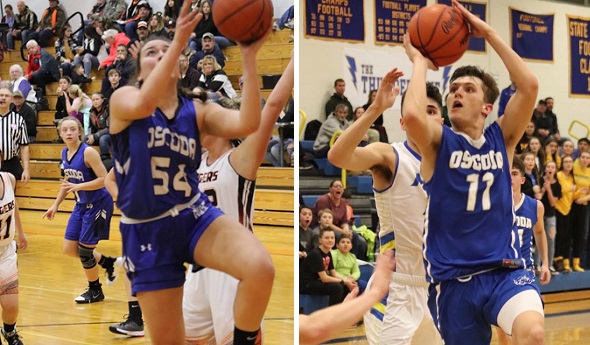
Oscoda Teams Rise From Past to Perfection
February 8, 2019
By Chris Dobrowolski
Special for Second Half
OSCODA — The tide has turned in Oscoda.
 After struggling year after year in boys and girls basketball, the Owls are enjoying quite a turnaround on the hardcourt this winter as both teams enter the final month of the regular season undefeated — just one of two schools in the state to be collectively unbeaten in boys and girls hoops.
After struggling year after year in boys and girls basketball, the Owls are enjoying quite a turnaround on the hardcourt this winter as both teams enter the final month of the regular season undefeated — just one of two schools in the state to be collectively unbeaten in boys and girls hoops.
The boys team boasts a record of 15-0 and is 9-0 in the North Star League Big Dipper division, while the girls squad has cruised to a 12-0 mark, including going 5-0 in league play.
It hasn’t always been that way, however.
“There’s a lot of years where we really struggled,” said Oscoda varsity boys basketball coach Seth Alda, a 2003 graduate of the school who is in his seventh year at the helm. “It wasn’t that long ago. There were a lot of years where we not only struggled but a lot of teams beat us by quite a bit.”
The boys team has reached a stretch where it has failed to win a league championship in 27 years or District title in 18 straight seasons, while the girls program became infamous for having lost 89 consecutive games at one point.
“We went almost four and a half years without winning a game,” said Oscoda varsity girls basketball coach Mark Toppi, who took over the girls program four years ago. “They had only had a couple wins in the past three years before I took the job.”
The Owls had been caught in a rut for most of the last few decades, partly due to a precipitous decline in the school’s enrollment after Wurtsmith Air Force Base was decommissioned in 1993. As families left the area, Oscoda became a shell of itself. At one time Class B playing within the North East Michigan Conference, the school was unable to remain competitive with its league rivals as its student population was slashed in half. It eventually made sense to leave the NEMC, and Oscoda toiled as an independent before finding a landing spot in the Huron Shores Conference, which eventually morphed into a reconfigured North Star League in 2014.
Things began to trend in the Owls’ favor last season as a group of talented and ambitious athletes started making their mark. It’s a core of players who have gotten better by working hard, dedicating themselves, including honing their games and picking up additional competition on local travel teams.
 “We kind of saw it coming,” said Alda. “Last year we were 14-8, which was our first winning season in 15 years. We returned a lot of players off that team. Last year we were young, and this year we’re still young. We have a lot coming back next year too.”
“We kind of saw it coming,” said Alda. “Last year we were 14-8, which was our first winning season in 15 years. We returned a lot of players off that team. Last year we were young, and this year we’re still young. We have a lot coming back next year too.”
The Owls’ main core consists of juniors Brayden Mallak, Gabe Kellstrom, Devin Thomas and Chance Kruse, as well as sophomores Owen Franklin and Gavin Lueck.
“We’re guard-oriented,” said Alda. “We like to get up and down the court. We press. We shoot a lot of threes. Typically, we go four out and one in — four guards and one post player. We like to push the tempo. We like to increase possessions. We’ve got three kids (Mallak, Kellstrom and Franklin) who are shooting over 35 percent — a couple of them over 40 — from the 3-point line.”
The girls team managed to come up with 13 wins a year ago despite not having a senior on the roster. That was part of the ascent from three victories in Toppi’s first season, to seven wins two years ago. The 13-9 record in 2017-18 earned Toppi the Associated Press’ Class C Coach of the Year Award.
With all that returning experience from the best girls team Oscoda had seen in years, the Owls were primed for an even better season.
“I could tell we were going to have a good year, just because of all the work they put in over the summer,” said Toppi. “We had a lot of success (last summer). We play up all the time whenever we go to team camps. We always try to play Class B or Class A schools. We take a lot of beatings in the summer. This year was the first year that we were winning against some of those schools. That was a nice sign. I try to tell them, ‘If we’re losing by 15 to a Class A school, that’s not bad.’ This year we were beating some of them.”
The Oscoda girls team has a bit more experience than the boys, with senior Katelyn Etherton in her fourth year as a starting guard. She reached the 1,000-point mark in her career earlier this year. Junior post player Lauren Langley is another key veteran who teams with Etherton, and each average close to 17 points per game. Sophomore Macy Kellstrom leads the team in steals and assists as the point guard, and classmate Izzy Hulverson is averaging a double-double in points and rebounds.
The problem the girls team has discovered is it isn’t getting pushed by the teams on its schedule. The Owls are winning by an average of 34 points per game. A 41-25 win over Tawas was the closest to date. Toppi hopes not having a close game during the regular season won’t hurt the Owls when they get to the postseason. For now, he’s just focused on getting the Owls ready for a tournament run.
 “I’m just trying to get them to play hard and practice hard,” he said. “I don’t want them to look at the schedule. We’re still trying to get competition in practice and get better every day.”
“I’m just trying to get them to play hard and practice hard,” he said. “I don’t want them to look at the schedule. We’re still trying to get competition in practice and get better every day.”
The boys games have been a little less one-sided, particularly two clashes against league rival Mio. Oscoda beat the Thunderbolts both times, but one was a seven-point win in a back-and-forth game a week ago and the other was a 35-33 nail-biter earlier this season that wasn’t decided until Mallak drove the length of the court and scored on a buzzer beater.
The buzz has caught up to the Owls as the wins have continued to pile up for both teams.
“Around the school I feel like everybody’s wearing Oscoda across their chest a lot more proudly than what it was a while ago,” said Franklin. “Wherever you go, people know who you are now.
“Every practice Mr. Alda talks to us about how we could be the first in so many years to do this (or that). Early in the year we were 8-0 and he was like, ‘You’ve got a chance to go 9-0. That hasn’t happened in 30 years. He talks to us a lot about making history.”
The struggles the school endured in basketball are not forgotten, but both teams are doing their part to make better memories on the court. The girls already snapped a 48-game losing streak to nearby rival Tawas, and the boys swept the Braves for the first time in 20 years. The boys team is also close to ending that elusive conference championship drought, and both teams have their eyes on earning some District tournament hardware.
“I keep talking about how exciting it is when you get to tournament time, if you can make a run,” said Alda, who was a freshman on Oscoda’s last basketball Regional champion in 2000. “This is just a really cool thing to be a part of.”
 Chris Dobrowolski has covered northern Lower Peninsula sports since 1999 at the Ogemaw County Herald, Alpena News, Traverse City Record-Eagle and currently as sports editor at the Antrim Kalkaska Review since 2016. He can be reached at [email protected] with story ideas for Manistee, Wexford, Missaukee, Roscommon, Ogemaw, Iosco, Alcona, Oscoda, Crawford, Kalkaska, Grand Traverse, Benzie, Leelanau, Antrim, Otsego, Montmorency, Alpena, Presque Isle, Cheboygan, Charlevoix and Emmet counties.
Chris Dobrowolski has covered northern Lower Peninsula sports since 1999 at the Ogemaw County Herald, Alpena News, Traverse City Record-Eagle and currently as sports editor at the Antrim Kalkaska Review since 2016. He can be reached at [email protected] with story ideas for Manistee, Wexford, Missaukee, Roscommon, Ogemaw, Iosco, Alcona, Oscoda, Crawford, Kalkaska, Grand Traverse, Benzie, Leelanau, Antrim, Otsego, Montmorency, Alpena, Presque Isle, Cheboygan, Charlevoix and Emmet counties.
PHOTOS: (Top) Lauren Langley, left, and Brayden Mallak have been key to Oscoda’s perfect starts; Mallak here hits the game-winning shot against Mio. (Middle) Katelyn Etherton beats everyone to the basket during a win over Lincoln Alcona. (Below) The Owls celebrate that Mio victory Dec. 13. (Photos courtesy of the Oscoda girls and boys basketball programs.)
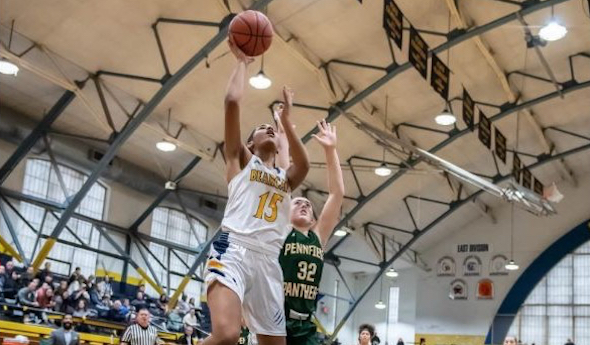
Hoops Finds Annual Home During Holidays
December 27, 2019
By Ron Pesch
Special for Second Half
Nothing says the Holidays like a high school basketball tournament.
It started, like many things do, with a drip. Well, make that a dribble.
The Michigan High School Athletic Association has allowed Holiday basketball tournaments for years. When was the first? That’s hard to establish. No one really kept track of such. A 1934 Wakefield News article indicates that a “Christmas Tournament will be held for the (Gogebic) Range teams at Wakefield December 27 and at Ironwood December 28.” Hurley, Bessemer, Ironwood and Wakefield were entered in the “blind” tournament, with opponents drawn just before game time. It was a new idea, at least in the Upper Peninsula.
“Nothing of its kind has ever been attempted in the Peninsula before,” stated the Ironwood Daily Globe. The tournament, won by Hurley, was a financial success. After expenditures, including the purchase of trophies, profit equaled enough that $22.42 was distributed to each school competing in the tournament. Plans were announced to bring back the tournament in a larger format the following year. It did return the following December, with the same teams in the same format but with all games played in Wakefield. This time out, Ironwood topped Hurley 22-21 for the tournament title.
In the Lower Peninsula in 1935, an All-Berrien County Holiday tournament was held Dec. 26, 27 and 28, with Three Oaks winning the Class B-C division title, 15-13 in the final over Berrien Springs. St. Joseph Catholic emerged as the Class D victor with a surprising 27-26 win over the reigning MHSAA state champ from Stevensville. The 14-team competition was played at Niles High School. Attendance was “slim, very slim” for the opening day of the tourney. The event did not return in 1936.
A similar, but much smaller, event was staged in Berrien County in 1941 with the Bridgman Class C Invitational. The tournament featured seven teams with contests spread over three nights. It was a success.
“Some 450 paid admissions were checked in Wednesday night for the championship finals, which Bridgman won from Berrien Springs. … The total paid admission for the three night event was 1,420 fans with a gross gate of approximately $400.”
By the mid-1940s, the idea of playing prep basketball during the Christmas lull had begun to take off across the state.
In December 1946, before a crowd of 1,500 at the Flint IMA Auditorium, Holland, the reigning Class A champion, downed Flint Northern 51-48 behind a pair of late field goals by Ken ‘Fuzz’ Bauman in the first annual Motor City Invitational. In Jackson, Detroit Catholic Central won the Michigan Catholic Invitational, beating Kalamazoo St. Augustine, 42-40. Bridgman again snagged the title at the Sixth Annual Berrien Class C Christmas Holiday Tournament. It was the Bees’ third Christmas championship in four years. The Little Eight Conference Holiday Tournament was played across four school gymnasiums as the calendar transitioned from 1946 to 1947. Bangor downed Covert, 34-29, in the championship contest hosted at Watervliet High School on Saturday, Jan. 4.
“Holiday tournament basketball has really caught on in Michigan,” said Hal Schram in the Detroit Free Press in 1947. “There will be no Christmas-New Year’s rest for at least 60 Michigan high school squads which have jumped at the chance to sharpen their collective shooting eyes for the long season ahead. … At last count, tournaments will be played between Dec 17 and Jan 3 at Flint, Saginaw, Grand Rapids, Jackson, Lincoln Park, Fremont, Negaunee, Marquette, Benton Harbor and Detroit.”
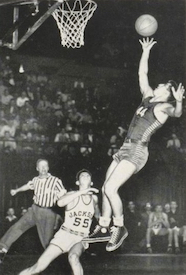 The same eight schools that played at the first Motor City tournament – Jackson, Grand Rapids Central, Holland, Muskegon Heights, Monroe, Midland, Flint Central and Flint Northern – were invited back for the second year. According to Schram, “Not a single participating school of a year ago wanted to be left out.”
The same eight schools that played at the first Motor City tournament – Jackson, Grand Rapids Central, Holland, Muskegon Heights, Monroe, Midland, Flint Central and Flint Northern – were invited back for the second year. According to Schram, “Not a single participating school of a year ago wanted to be left out.”
Jackson downed Flint Northern in the title game, 39-34.
The Saginaw Invitational, hosted at Arthur Hill High School, boasted six Class A schools as well as Alma and Mount Pleasant, both Class B schools. Mount Pleasant surprised the field, winning the tournament with a 40-25 triumph over Dearborn Fordson in the championship game.
A year later in December, Schram wrote, “The Michigan High School Athletic Association wasn’t caught unaware when the tournament bug started to bite every sector of the state.”
“Never did we expect such a wave of tournament play as we will see during the next three weeks,” said Charles Forsythe, state director for the MHSAA, noting 34 Christmas vacation tournaments were scheduled between December 15 and January 8 during the 1948-49 basketball season. “Perhaps we’re lucky at that. The Oklahoma association has had to sanction 123 tournaments.”
Forsythe and Schram explained the reasons for the wave of popularity. Of particular interest was the fact that, at the time, a school sponsoring both football and basketball could play a total of no more than 24 games, combined, in the two sports. However, MHSAA rules allowed a basketball team the chance to play as many as three games during a Holiday tournament and be charged with only one of its allotted combination of 24 contests. (The MHSAA rules changed prior to 1972-73 to allow basketball teams a maximum of 20 games.)
Coaches could keep their squads sharp during the two-week layoff with games rather than just mandatory practices. And, as a bonus to all because tournaments were financed through gate admissions, invitations to larger tournaments meant teams got to “stay and eat at the best hostelries, go on sightseeing tours when not playing and play non-conference opponents from other sections of the state.“
Add in the chance to play before larger-than-normal crowds, and the formula for a successful tournament was cast.
Beginning with the 1950-51 season, the football-basketball rule was altered to count play in mid-season invitational tournaments as two contests. With the change, according to the Detroit Times, “the number of such meets dropped sharply.”
Only nine Holiday tournaments, involving 50-plus teams, were recorded by the MHSAA during the 1951-52 season: the 5th annual Flint Parochial Invitational, the Alpena Catholic Invitational (involving 16 teams), the 5th Annual Greater Lansing Invitational, the Albion College Invitational, the Twin-Five Conference Christmas Tournament (a 10-team replacement for the disbanded Little Eight Conference’s tournament), the Otisville Invitational, the Columbiaville Invitational and the 1st Annual Portland St. Patrick Christmas Invitational.
But by the 1960s, Holiday Tournaments were again regaining popularity, with more now focused on teams from a specific community or section of the state, especially among smaller schools.
The St. Patrick tournament was still going strong in 1966 – its 15th year – with an eight-team, four-day design. Williamston downed a Cinderella squad from Carson City, 64-44, before 1,100 fans at Portland to earn the championship. Other Mid-Michigan holiday tournaments played out in Chelsea and Swartz Creek at the same time.
The Flint Parochial League Tournament was a mainstay of the Holiday season until the breakup of the league in the early 1970s.
“Basketball tournaments have become popular around the state and nation in recent years,” wrote Wendy Foltz, longtime Battle Creek Enquirer sports editor, before the kickoff of the inaugural Battle Creek Central Holiday Cage Tournament in 1968. In a twist that harkened back to earlier days, the eight-team event represented nearly every section of lower Michigan. “Battle Creek never has been a rabid basketball town like some around the state,” added a hesitant Foltz, noting a hope that the event could at least break even.
Hosted at the Cereal City’s historic Fieldhouse, built in 1928, that first tournament was won by host Battle Creek Central, which downed Traverse City 71-53 before a crowd of 2,000. Phil Todd led the Bearcats with 29 points, including 21 in the first half, while 6-foot-8 Tom Kozelko paced TC with 24. Muskegon Heights won the consolation game, holding off a late Ypsilanti Willow Run rally, 78-77. Other schools competing were Battle Creek Lakeview, Grand Blanc, Romulus and recently-opened Jackson Lumen Christi.
Chuck Turner, Central’s head coach, and junior varsity coach Jack Schils had contacted 60 schools during the summer of 1967 to organize the 12-game schedule.
“The response was terrific,” said Schils, who added, “Many schools could not accept because of schedule commitments but want to enter a year hence.”
The Battle Creek tournament was back in 1969, again hosting teams from near and far. Schils noted that cost ran high when teams were brought in from long distances: “However, this type of tournament is highly desirable so we hope fans will support it.”
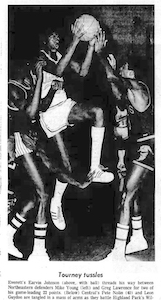
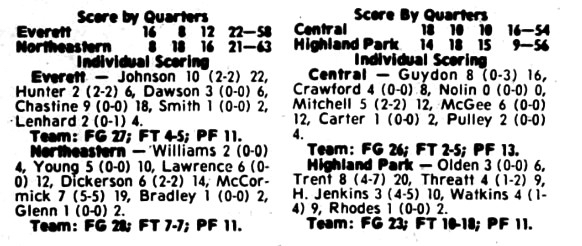 But the event was discontinued following the 1970-71 season when the “eight team format became too unwieldy,” according to the Enquirer “… and both crowd and the quality of play declined.”
But the event was discontinued following the 1970-71 season when the “eight team format became too unwieldy,” according to the Enquirer “… and both crowd and the quality of play declined.”
Pared down to a four-team format, it returned in a big way in December 1975. The tournament saw standing-room-only crowds of more than 3,000 for games between Battle Creek Central, Detroit Northeastern, Class A quarterfinalist Lansing Everett and reigning Class A champion Highland Park.
Detroit Northeastern downed Lansing Everett, 63-58 for the Cereal City championship trophy. Everett junior Earvin Johnson scored 22 points and, with teammate Reggie Chastine, was named to the all-tournament team along with Northwestern’s Wilbert McCormick, the tourney MVP, and his teammate Greg Lawrence. Highland Park’s William Trent and Battle Creek Central’s Leon Guydon also were named to the team.
By the 1980s, it seemed that the Christmas break nearly mimicked March in Michigan.
“I think a Christmas tournament really helps your program,” said Turner in 1980 to the Enquirer. He had taken over the head coaching position at Battle Creek in the fall of 1967 after a successful stint at Willow Run. “I don’t understand basketball teams having a preseason, playing three or four games, then taking two weeks off. When you get back, it’s like starting over.”
Besides Turner’s squad, the 1980 field included Detroit Western, Detroit Murray Wright and eventual winner Kalamazoo Central. The event would ultimately be re-christened the Battle Creek Central Chuck Turner Holiday Classic.
“The late Chuck Turner started bringing big games to the city over the holidays when he first started at the school in the 1960s,” wrote Bill Broderick in the Enquirer in 2018.
“Chuck started this because he wanted to give people the chance to come back home for the holidays and see everyone play. It’s been like a family reunion over the years,” Fred Jones told Broderick. Jones was a longtime assistant to Turner. “That we can keep it going in his name is great and hopefully we can keep if going for another 50 years.”
The girls are now part of the action. All five Battle Creek city schools – Central, Pennfield, Harper Creek, Lakeview, and St. Philip – were part of the event in 2018.
This year the Chuck Turner Central Field House Holiday Classic will again span two days – December 27 and 28 – and will again see all five city schools play on the historic floor.
Other Holiday tournaments scheduled this year include:
Petoskey Invitational – December 13-14
Raider Shootout – December 21
18th Annual Muskegon Area Sports Hall of Fame Classic – December 27
Earl McKee Classic – December 27-28
North Farmington Holiday Extravaganza – December 27
Motor City Roundball Classic – December 27
Cornerstone Invitational – December 27
Washtenaw Hoops Showcase – December 28
 Ron Pesch has taken an active role in researching the history of MHSAA events since 1985 and began writing for MHSAA Finals programs in 1986, adding additional features and "flashbacks" in 1992. He inherited the title of MHSAA historian from the late Dick Kishpaugh following the 1993-94 school year, and resides in Muskegon. Contact him at [email protected] with ideas for historical articles.
Ron Pesch has taken an active role in researching the history of MHSAA events since 1985 and began writing for MHSAA Finals programs in 1986, adding additional features and "flashbacks" in 1992. He inherited the title of MHSAA historian from the late Dick Kishpaugh following the 1993-94 school year, and resides in Muskegon. Contact him at [email protected] with ideas for historical articles.
PHOTOS: (Top) The Battle Creek Central and Pennfield girls face off during the 50th Chuck Turner Classic. (Middle) Shaheen Shaheen scores two points for Flint Northern, which fell to Jackson 39-34 during the 1947 Motor City championship game. (Below left) Lansing Everett’s Earvin Johnson makes a move toward the basket against Detroit Northeastern during the 1975 Battle Creek event. (Below right) Box scores from the 1975 tournament include Johnson’s 22 points in the 63-58 loss. Photos courtesy of the Battle Creek Enquirer, Lansing State Journal and Ron Pesch archives.)

